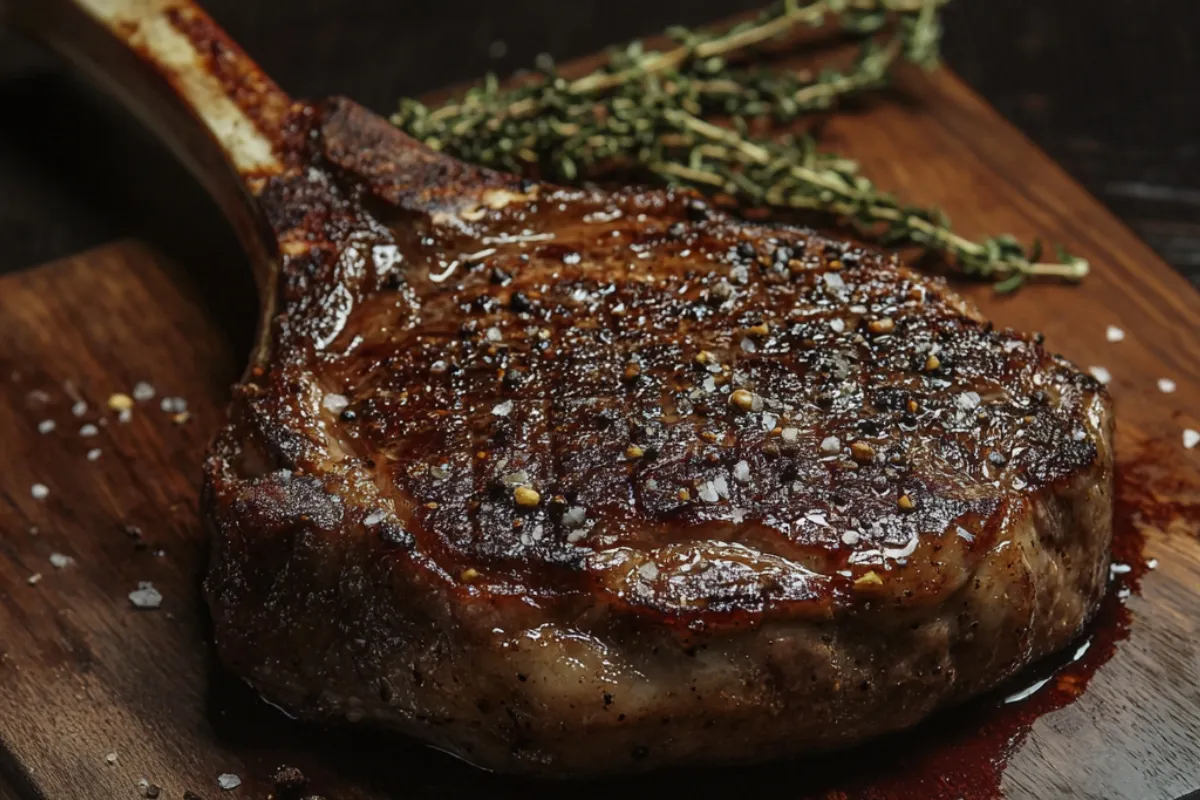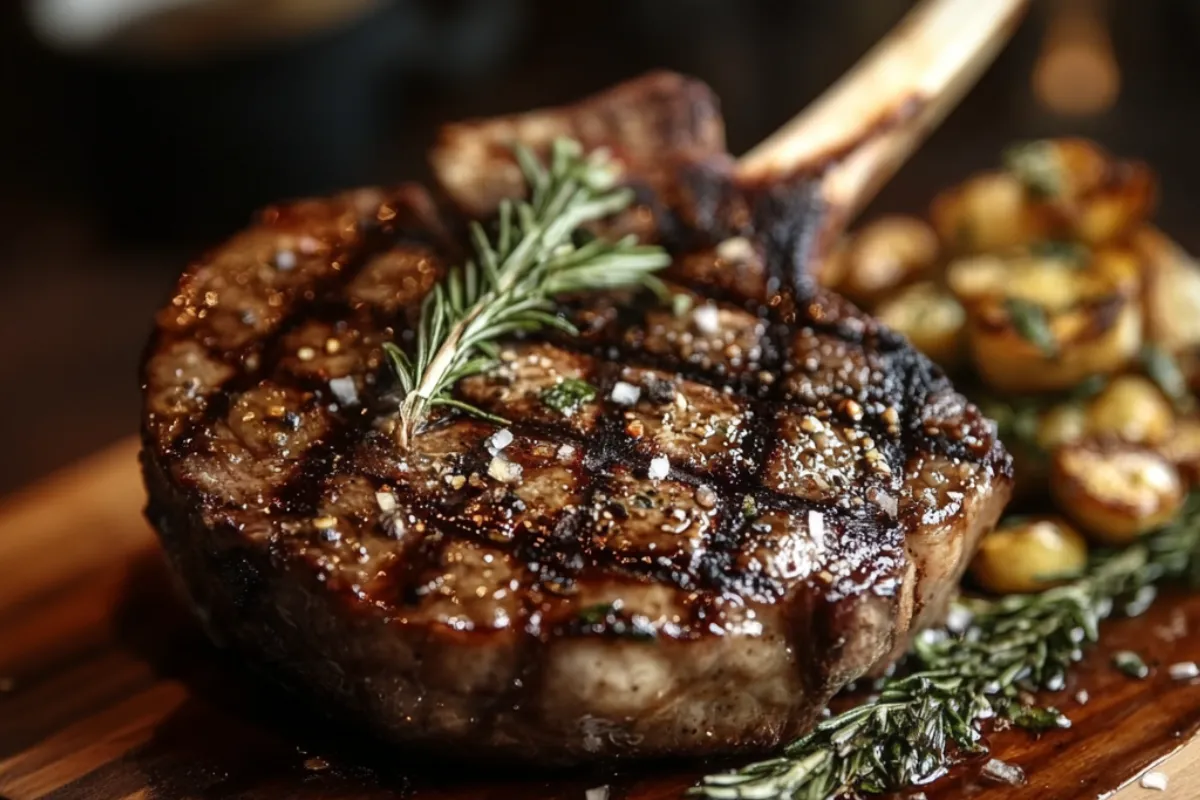If you’re familiar with high-end dining or have visited a steakhouse, chances are you’ve encountered the tomahawk steak. With its long, frenched bone and substantial size, this cut of meat isn’t just a meal; it’s a luxurious experience. The price tag, however, can be quite intimidating. So, what makes the tomahawk steak so expensive? In this article, we’ll break down the key factors contributing to its high cost, compare it to other cuts, and explore cooking techniques that add even more value to this already premium steak.

Introduction to Tomahawk Steak
The tomahawk steak is a ribeye steak that features a long bone, carefully frenched to enhance its presentation. This cut of beef has become synonymous with luxury, primarily due to its impressive appearance and the rich, beefy flavor it offers. But is it really worth the price? Before we dive into the specifics, you may want to explore this ultimate guide to cooking and enjoying a tomahawk steak to better understand how to cook and appreciate this exquisite cut of meat.
The Anatomy of a Tomahawk Steak
The tomahawk steak is derived from the rib primal, specifically from ribs 6 through 12. It’s essentially a bone-in ribeye, but the presentation is elevated by leaving the bone long and cleaning (frenching) it. This process takes time and expertise, both of which contribute to the overall cost of the steak.
If you’re curious about the specific cut of steak that makes up the tomahawk, you can explore more details in this related article: What cut of steak is a tomahawk?.
Why Tomahawk Steak is More Expensive: Key Factors
There are several reasons why the tomahawk steak comes with a hefty price tag. Let’s break down the most important factors:
1. Large Size and Thickness
One of the most prominent reasons behind the high price is its sheer size. The average tomahawk steak weighs between 2 and 3 pounds, and its thickness can reach over 2 inches. That’s a lot of meat, and more meat equals a higher cost.
- The tomahawk steak’s thickness also requires specialized cooking techniques to ensure it cooks evenly, which adds to the time and effort needed to prepare it.
2. Frenched Bone Labor
Preparing a tomahawk steak involves a process called frenching, where the butcher removes the fat and meat from the bone, leaving a clean handle. This labor-intensive technique requires a skilled butcher and adds to the cost.
3. Presentation and Visual Appeal
In the world of fine dining, presentation matters. The tomahawk steak’s dramatic appearance, with its long bone and thick, juicy cut, makes it a show-stopper on any dinner table. Restaurants capitalize on this visual appeal, which can justify the higher price, especially in high-end establishments.
Quality and Flavor Profile of Tomahawk Steaks
The tomahawk steak isn’t just expensive because it looks impressive; it also delivers when it comes to flavor and tenderness. Let’s explore why the taste of this steak makes it worth the splurge.
1. Marbling and Tenderness
The marbling in a tomahawk steak is what gives it that melt-in-your-mouth texture. The fat that runs through the meat breaks down during cooking, making the steak juicy and tender. This is why USDA Prime tomahawk steaks are even pricier — they have the highest level of marbling, resulting in superior tenderness.
2. Superior Flavor
Cooking a tomahawk steak with the bone attached enhances the flavor. The bone conduction during cooking releases flavors into the meat that you wouldn’t get with a boneless cut. This creates a richer, beefier taste that many steak lovers are willing to pay extra for.
Premium Pricing in Restaurants
If you’ve ever ordered a tomahawk steak at a restaurant, you might have noticed its price far exceeds other cuts on the menu. Here’s why:
1. Restaurant Markups
Restaurants typically charge 2-3 times the cost of the meat to cover overhead, labor, and ambiance. The tomahawk steak, often featured as a luxury item, commands a higher price due to its visual appeal and the labor required to prepare it.
For a detailed breakdown of typical restaurant markups for premium steaks, check out this supply chain and costs of premium meat.
2. The Role of Exclusivity and Ambiance
In a high-end steakhouse, ordering a tomahawk steak is about more than just eating a meal — it’s an experience. The ambiance, presentation, and service elevate the dining experience, and this exclusivity is reflected in the price.

Tomahawk Steak vs. Other Cuts: Price Comparison
Let’s compare the tomahawk steak to other popular cuts of beef to better understand why it costs so much.
1. Tomahawk vs. Ribeye
At its core, the tomahawk steak is essentially a ribeye with a longer bone. The taste and texture are nearly identical, but the labor-intensive preparation and the dramatic presentation of the tomahawk make it more expensive.
2. Tomahawk vs. T-bone/Porterhouse
The T-bone and porterhouse are also bone-in cuts, but they don’t have the same visual impact as a tomahawk. Although these steaks offer a combination of tenderloin and strip steak, they are generally priced lower because they don’t require the same level of preparation or presentation.
Production and Supply Chain Costs
The rarity and production costs of tomahawk steaks also play a significant role in their price.
1. Rarity of the Cut
Only a limited number of tomahawk steaks can be sourced from each cow, making it a relatively rare cut. This scarcity drives up the price.
2. Import/Export and Geographic Factors
In many cases, tomahawk steaks are imported from regions known for premium beef, such as Wagyu beef from Japan. The cost of importing these cuts adds to their price.
3. Impact of High-Quality Beef Standards
Tomahawk steaks that meet higher beef standards, such as USDA Prime, are priced at a premium. These steaks have superior marbling and tenderness, making them more expensive than lower-grade cuts.
Cooking Techniques: Added Value in Price
Cooking a tomahawk steak is no easy feat. The size and thickness require special techniques to ensure that the meat is cooked perfectly, which also adds to its cost.
1. Specialty Grills and Equipment
Due to the size of the tomahawk steak, it often requires larger grills or specialized cooking equipment. This adds complexity to the cooking process, which increases the cost of preparing the steak.
2. Time-Intensive Cooking Methods
Many chefs use methods like reverse searing, which involves cooking the steak at a low temperature before finishing it on a high-heat grill to create a perfect crust. This method takes longer but results in a more flavorful steak, justifying the higher price.
FAQs About Tomahawk Steak
What is the difference between a tomahawk steak and a ribeye?
- A tomahawk steak is a ribeye with a long, frenched bone. While the meat is essentially the same, the bone adds visual appeal and enhances the flavor.
How much does a typical tomahawk steak weigh?
- A typical tomahawk steak weighs between 2 and 3 pounds, but it can sometimes weigh even more.
Is tomahawk steak worth the price?
- Many people feel that the flavor, tenderness, and presentation make the tomahawk steak worth its high price. However, others might prefer the similar taste of a ribeye at a lower cost.
Can I cook tomahawk steak at home?
- Yes, but you’ll need a large grill and knowledge of cooking techniques like reverse searing to achieve the best results.

Conclusion: Is the Price Justified?
When you consider all the factors — size, presentation, labor, flavor, and exclusivity — it’s easy to see why the tomahawk steak expensive is priced so high. For steak enthusiasts, the experience of cooking or ordering a tomahawk steak is often worth the splurge, especially when enjoyed in a fine dining setting. The steak’s impressive appearance and rich, beefy flavor make it a memorable dish that stands out from other cuts.
However, for those who are simply looking for a delicious meal without the fanfare, a ribeye might offer similar flavor at a lower cost. Either way, the tomahawk steak is sure to make a statement at any gathering or special occasion.

